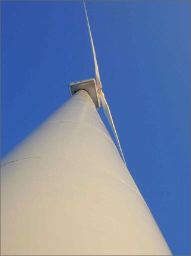
|
Steve Gilbert, Chugach's manager for energy projects development, said that if the project is expanded to its full scope of 100 megawatts, it would reduce Chugach's requirements for natural gas to fuel its electrical power plants by 14 percent.
Chugach is one of the biggest users of natural gas in the state, and reserves in Cook Inlet region gas fields are running low.
Gilbert said Chugach expects to complete its feasibility studies on the project by the end of this year. Chugach has issued requests for proposals for construction of a 138-kilovolt transmission line to the island as well as route studies and related civil and environmental studies. Proposals were expected back May 7, Gilbert said. The Denali Commission has provided funding to help the project, he said.
In addition to supplying electricity to the main Chugach grid, the project could supply power to federal facilities now on the island. The Federal Aviation Administration and U.S. Coast Guard maintain air and marine navigation facilities on Fire Island.
Chugach has been engaged in wind studies on the island since 2000 and has been evaluating other sites for wind generation in the Anchorage bowl since 1998, Gilbert said.
The "base case" for the Fire Island project, estimated to cost about $80 million, involves 33 wind turbines each generating 1.5 megawatts of electricity. Chugach is also studying installation of larger 3-megawatt turbines that could generate a total of 100 megawatts, Gilbert said.
The larger turbines would raise the cost to about $100 million. Although the larger turbines would raise the initial cost of the project, more power would be produced so the cost per kilowatt hour of electricity would be lower, Gilbert said.
"Wind power is renewable and like other forms of renewable energy, like hydro, the up-front capital costs are high. But the long-term life-cycle costs of the project are lower because there is no fuel cost," Gilbert said.
Natural gas power generation projects can typically be built for about $800 per installed kilowatt hour-per-year of generation capacity, as an example, while wind power projects typically cost $1,200 per kilowatt hour of capacity, he said.
But natural gas is getting more expensive in Southcentral Alaska, while wind is free, Gilbert said.
Wind compares favorably in terms of cost with other alternatives for power supply, such as coal, although in the long run the large coal resources at Beluga, west of Anchorage, and at Healy, in Interior Alaska, should be part of an overall energy plan for the state's railbelt utilities.
If the Fire Island project was approved and financing lined up early next year, it could possibly be up and running as early as 2006, but such a fast-track schedule might be optimistic, Gilbert said. Chugach's management and board must first consider and approve the project if the feasibility studies are positive, Gilbert said.
"We also have discussions underway with Municipal Power and Light and Golden Valley Electric Association on some form of participation in the project," Gilbert said. ML&P, owned by the Municipality of Anchorage, and GVEA, the Interior Alaska electric utility, could buy power generated from the wind project, or partner with Chugach on portions of the project.
"A project of this size would have to be split among the other railbelt utilities," Gilbert said.
ML& P and Chugach have agreed on a memorandum of understanding to work cooperatively on the project, he said.
Most of the land on Fire Island is owned by Cook Inlet Region Inc. Carl Marrs, CIRI's president, said the wind project could reduce Chugach's dependence on natural gas for power generation. There are concerns about future shortages of gas in the Southcentral Alaska region because producing gas fields in the region are being depleted, Marrs said.
Gilbert said that if the project moves forward, as many as 100 construction workers will be needed to build the transmission line, a power substation, new roads on Fire Island and installation of the wind turbines.
"After the project is operating a crew of skilled people would be required to operate and maintain the project," Gilbert said. "The project also includes a perspective training site where people could train on operation of wind turbines for not only the other railbelt regions of the state but also for rural village wind power applications."
Several rural Alaska utilities, such as Kotzebue Electric Association and Alaska Village Electric Cooperative, are engaged in wind power projects.